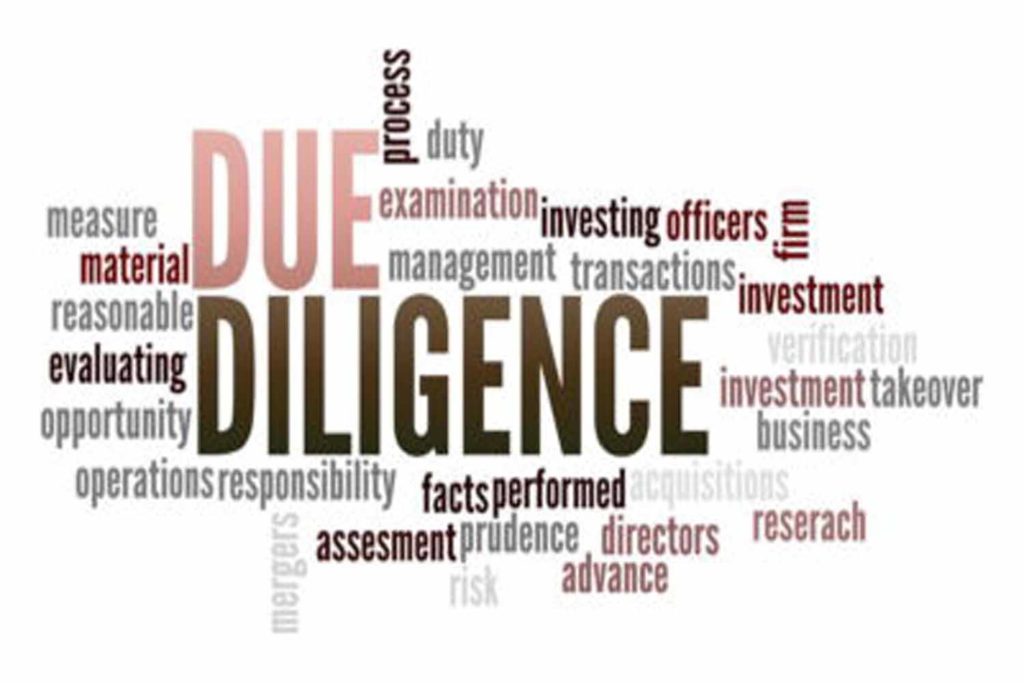Buying a business is a risky endeavor. What makes the process even more nerve-wracking is that a business is different from just about any other asset one can buy. When one purchases a house, car, or other tangible product, a buyer usually knows what they are getting, can inspect the product, and can inspect the goods, giving one a chance to uncover hidden problems (or pay an expert to find them). A business, in contrast, is largely intangible. While some aspects may be tangible, most are not. Because there are so many hidden traps in buying a business, purchasers will usually engage in due diligence on their target acquisition. The main purposes behind due diligence are (1) verifying the information provided by the seller is accurate; and (2) uncovering any material information that the seller has not already provided, either intentionally or unintentionally.
Due diligence usually begins after the parties execute a letter of intent The letter of intent will contain provisions providing for a due diligence period and will give the buyer access to the target acquisition’s records. Due diligence will then usually have two phases: (1) a request is made for certain written documents, which the buyer then reviews; and (2) the buyer conducts on-site verification possibly using interviews of company personnel. There are normally three parts to the due diligence process: (1) legal; (2) financial; and (3) operational.
I began a blog series on the M&A process as a whole and drafted a general blog regarding the due diligence process. Because due diligence is arguably the most important part of the process of purchasing a business, I take a deeper look into this aspect of the mergers and acquisitions process in a three part series. This blog, which takes a deeper view of the legal aspect of due diligence, is the first in this series.
Legal Due Diligence
The legal portion of due diligence involves ensuring: (1) the company has been validly formed and exists, (2) the buyer has an accurate understanding of the company’s ownership and the rights of the different owners and the company’s management; (3) the buyer understands what litigation is pending or could arise in the future; (4) the current insurance is adequate; and (5) the company is in compliance with all applicable laws and regulations.
Below is a non-exhaustive list of types of documents a buyer should request during due diligence. Of course, every deal is different, so there are likely additional documents that would be necessary in any particular.
To ensure corporate existence and ownership rights, a buyer should request:
- The company’s organizational documents. If the company is a corporation, this includes any charter, articles of incorporation, certificate of incorporation, bylaws, and stock certificates. If the company is an LLC, this includes any articles of organization, certificate of organization, operating agreement, and membership certificates.
- Any record of meetings of the board, shareholders, members, or managers, plus any subset of the foregoing operated as a committee. Also request any stockholders lists or records books.
- Any documents required by a state other than the company’s state of incorporation that permit the company to do business in that other state. These are frequently called “foreign qualification documents.”
- Any kind of agreement giving owners options, rights of first refusal, preemptive rights, warrants, or any agreement limiting the owners’ rights to transfer their ownership interests or the ability of owners to vote their share/interests. For a corporation, this is frequently included in a stockholder’s agreement or a buy/sell agreement and in an LLC, this is frequently included in the operating agreement.
- If the company has any subsidiaries or affiliates which will be involved in the deal (as part of the target or otherwise), a list of those subsidiaries and affiliates, and the items above for each subsidiary or affiliate.
To ensure what litigation is pending or could arise in the future, a buyer should request:
- A list of all threatened or pending litigation over the past five years.
- The files of all litigation included in all of the threatened or pending litigation over the past five years.
- If the seller has hired a law firm, a letter certifying that the firm knows of no threatened litigation or contingent liabilities. This may be difficult to obtain if no firm regularly represents the interests of the target.
- Documentation as to who owns the IP of the firm. It must be clear that the company owns the IP of the frim and not any employee, founder, or other party. Otherwise the buyers is just purchasing a lawsuit.
To ensure the current insurance is adequate:
- Copies of all insurance policies, including property casualty, general liability, D&O liability, and excess umbrella policies.
- A list of any claims made during the previous 5 years and any related correspondence.
Ensuring the company is in compliance with all applicable laws and regulations can vary greatly depending on the industry. It can be as simple as obtaining copies of business licenses and health inspections, or as complex as obtaining all reports, permits or registration statements, and disciplinary proceedings from a regulator that oversees the company, In addition, if the company owns real estate, separate due diligence needs to be done on the real estate, including environmental and title.
Conclusion
Due diligence is arguably the most important step in the M&A process for purchasers. It will aid in verifying the information previously provided by the seller and recovering any information not previously provided by the seller. Due diligence on a business involves reviewing a large amount of documents. This post covered but one third of the process. Stay tuned for future posts, in which I will discuss financial and operational due diligence.

